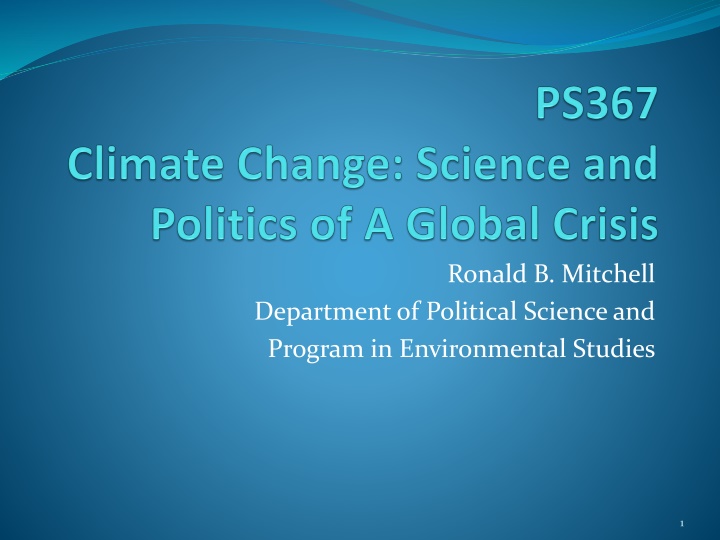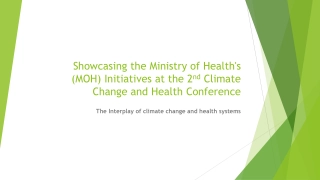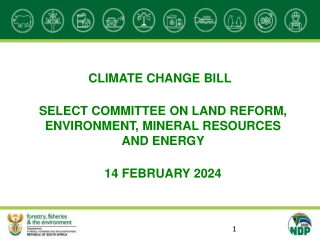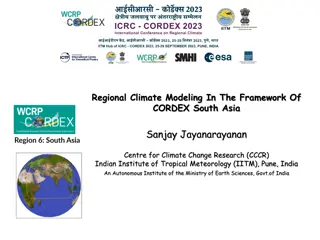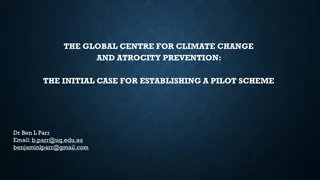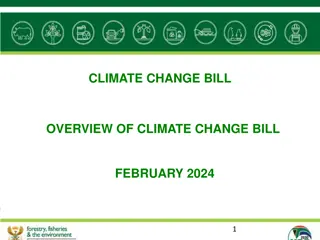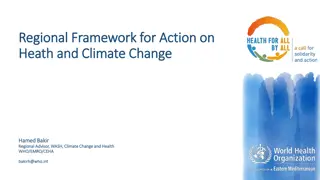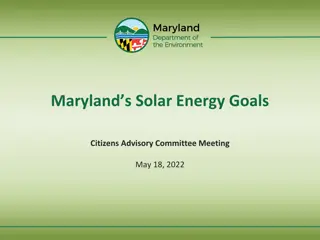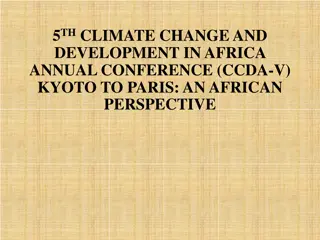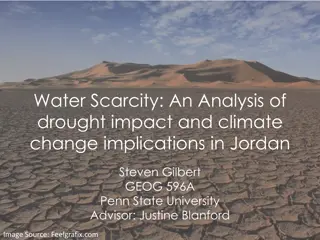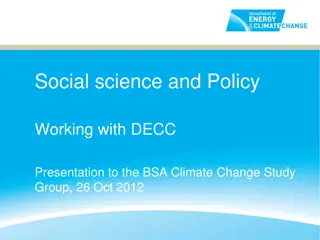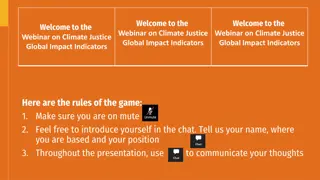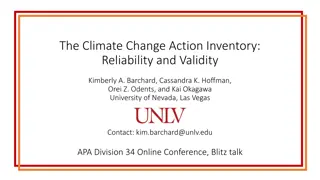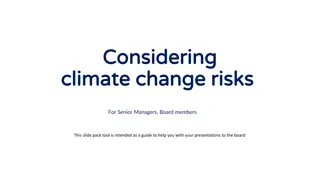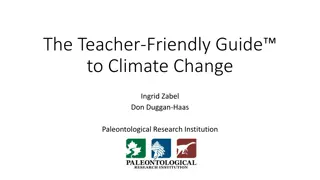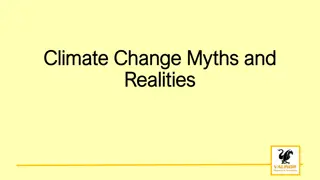Climate Change Course Outline and Learning Objectives
Dive into a comprehensive course outline covering the natural science basis of climate change, its likely impacts, ethical considerations, belief in science, economic and psychological aspects, and international responses. Understand key insights from various disciplines and learn about the Six Americas' perspectives on global warming. Explore expected learning outcomes and self-introductions, all aimed at enhancing your understanding of climate change and fostering critical thinking skills in addressing this urgent issue.
Download Presentation

Please find below an Image/Link to download the presentation.
The content on the website is provided AS IS for your information and personal use only. It may not be sold, licensed, or shared on other websites without obtaining consent from the author.If you encounter any issues during the download, it is possible that the publisher has removed the file from their server.
You are allowed to download the files provided on this website for personal or commercial use, subject to the condition that they are used lawfully. All files are the property of their respective owners.
The content on the website is provided AS IS for your information and personal use only. It may not be sold, licensed, or shared on other websites without obtaining consent from the author.
E N D
Presentation Transcript
Ronald B. Mitchell Department of Political Science and Program in Environmental Studies 1
Basic outline of course Intro Natural science basis of climate change Likely impacts Drivers of climate change Ethics and climate change Believing the science Economics // Psychology // Law // Sociology International / national / local responses Did Kyoto make a difference? Will Paris make a difference? Mitigation // Adaptation // Geoengineering Symposium of your research 2
Expected Learning Outcomes Understand key insights from a range of natural science and social science disciplines regarding a) the physical and chemical processes by which humans are believed to be influencing the global climate, b) the impacts that climate change is predicted to have for humans and the natural system, and c) the social forces that are fostering or inhibiting action to address climate change. Recognize the range of strategies to address climate change being used by individuals, nongovernmental actors, and governmental actors at the local, state, national, and international levels as well as the factors that contribute to or prevent their success. Demonstrate critical thinking and communication skills, including the use of counterfactuals, by writing a major research paper that requires using empirical evidence to assess theoretical claims about some aspect of the social science of climate change. 3
Self-introductions, including which of the 6 Americas you are in Self-introductions in a moment but before that: Intro to Six Americas: figure out which you belong to as part of your self-introduction 4
Six Americas defined Alarmed: most engaged in global warming. Very convinced it is happening, human-caused, and a serious and urgent threat. Making changes in their own lives. Support aggressive national response. Concerned: convinced global warming is serious. Support vigorous national response, but less involved in issue and less likely to take personal action. Cautious: believe that global warming is a problem, but less certain about it. Not a personal threat, and no urgency to deal with it. Disengaged:haven t thought much about it, don t know much about it, and could easily change their minds about global warming. Doubtful: split among a) global warming is happening, b) isn t happening, and c) don t know. If it s happening, due to natural changes, won t harm people for decades, and America is already doing enough. Dismissive: actively engaged in issue (like Alarmed) but on opposite side. Believe warming is not happening, is not a threat, and is not a problem. 5
Self introductions Which of the 6 Americas do you belong to? What DON T you know about climate change? What DO you know about climate change? Make 1 claim about climate change 9
Climate change: Science meets politics US Senator John McCain (2008): The burning of oil and other fossil fuels is contributing to the dangerous accumulation of greenhouse gases in the Earth s atmosphere, altering our climate. Former UK Prime Minister Tony Blair and Dutch Prime Minister Jan Peter Balkenende (2006): The science of climate change has never been clearer. UN Secretary-General Ban Ki-moon: The heat is on. We must act (2013) and Climate change is happening. The impact is real. The time to act is now. (2007) MIT Prof. Richard Lindzen (2006): Ambiguous scientific statements about climate are hyped by those with a vested interest in alarm. President Donald Trump (2015): I m not a believer in global warming. And I m not a believer in man-made global warming. EPA Administrator Scott Pruitt (2017): Measuring with precision human activity on the climate is something very challenging to do I would not agree that it's a primary contributor to the global warming that we see. US Senator James Inhofe (2015): Uses snowball to dismiss claims of climate change on floor of US Senate. US Congress National Defense Authorization Act (2018): It is the sense of Congress that climate change is a direct threat to the national security of the United States. 10
Climate change policy debate involves three types of claims Positive claims: about how world IS. Include both Descriptive inferences: THAT claims about things that happened we DIDN T observe Causal inferences: WHY claims about causes we CAN T observe Normative claims: about how world SHOULD be Prescriptive claims: about what we should DO Combine positive and normative claims 11
How do we know if a theory is true? Examples of theory and how you would know if the theory was true 12
How do we know if a theory is true? Examples of theory and how you would know if the theory was true 7 things to know Its warming / Its us / We re sure Ice melting / Weather disrupted / Species dying We can do something. Theory matches the facts Theory fits more facts better than previous theory Theory makes predictions beforehand and observations of real life match predictions 13
Read the syllabus All readings are online, but let me know if not Don t be daunted by large number of readings: total pages per class session is rather small. Do NOT count on me announcing all due dates. I will try to announce in class and via Canvas but your responsibility. All dates are on the Syllabus. 14
Office Hours PLC-921 Tu/Th 10:00-11:30 Those who sign up at door given priority but walk-ins always welcome
Assignment 0 on Plagiarism Academic Integrity Assignment Due date: Friday of Week 1 By enrolling in this course, you agree to abide by the University s Student Conduct Code. You must read: All links on Canvas assignment Make sure you understand what they imply about your conduct in this class. Raise any questions you have with the professor. 16
Assignment 1: Local trends -- Evidence of climate change yet? Go to: https://www.ncdc.noaa.gov/cag/statewide/time-series (Links to an external site.) Parameter: Choose whichever most interests you or try several times to get something interesting. Time Scale: change to 12-Month Month: -- leave as is Start Year: 1895 and End Year: 2018 State: Select any EXCEPT Oregon, California, or Washington (choose one you think other students will NOT choose). UNclick Display Base Period CLICK Display Trend AND Per Century CLICK Smoothed Time Series and Binomial Filter BEFORE you click Plot, think about which direction you expect the trend to be. To identify the graph most interesting to you, REPEAT the above steps keeping all selections the same BUT change Parameter (or State) and re-click Plot. Looking across your different attempts, what patterns do you see? Once you have identified the most interesting graph, do the following for just ONE: Right-Click anywhere on and select the option for "Save Image" or "Save Current Graph as PNG Image" or whatever your browser presents for saving the chart. If all else fails, take a screenshot of the graph. Name the file as Lastname.png (e.g., Mitchell.png) Submit assignment via the Assignment link in Canvas Grading criteria: turn in the assignment on time and according to the instructions. Due midnight Tuesday of NEXT WEEK!!! 17
Response papers Two during course of term Weeks 3 through 9 You have been assigned a response paper in each of 2 weeks (that are at least three weeks apart). Check Canvas for exact weeks your papers are due. Response papers are due BEFORE class begins on the day the readings are assigned for 18
Final paper plus 2 drafts due dates on syllabus Final research paper (40% total: 25% for plus 5% and 10% for drafts see below) 15-20 page research paper explaining, in depth, one of the policy components of the course (setting the agenda, international responses, non-international responses). Two paper drafts to help you build toward the final paper (5% and 10%, respectively) Present on Tues, Week 10, at research symposium 19
